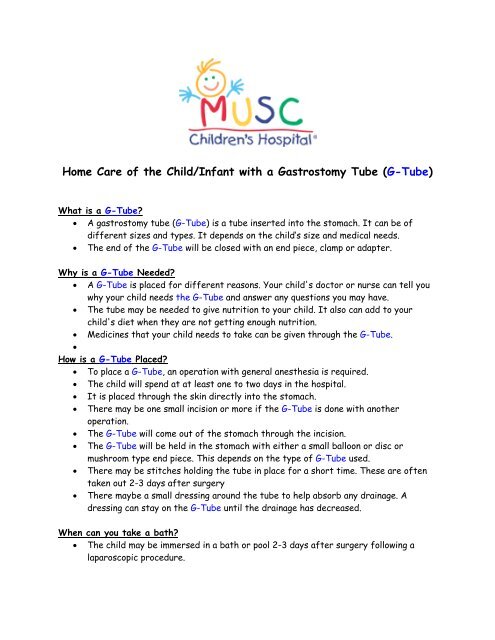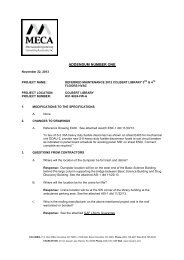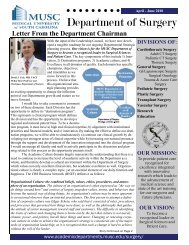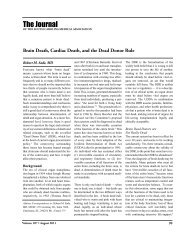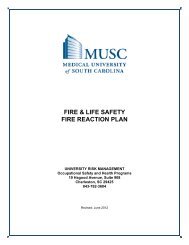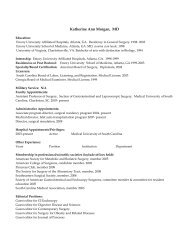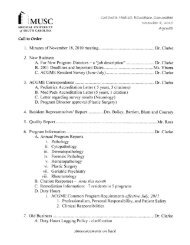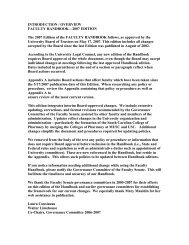Home Care of the Child/Infant with a Gastrostomy Tube (G-Tube)
Home Care of the Child/Infant with a Gastrostomy Tube (G-Tube)
Home Care of the Child/Infant with a Gastrostomy Tube (G-Tube)
You also want an ePaper? Increase the reach of your titles
YUMPU automatically turns print PDFs into web optimized ePapers that Google loves.
<strong>Home</strong> <strong>Care</strong> <strong>of</strong> <strong>the</strong> <strong>Child</strong>/<strong>Infant</strong> <strong>with</strong> a <strong>Gastrostomy</strong> <strong>Tube</strong> (G-<strong>Tube</strong>)<br />
What is a G-<strong>Tube</strong>?<br />
• A gastrostomy tube (G-<strong>Tube</strong>) is a tube inserted into <strong>the</strong> stomach. It can be <strong>of</strong><br />
different sizes and types. It depends on <strong>the</strong> child’s size and medical needs.<br />
• The end <strong>of</strong> <strong>the</strong> G-<strong>Tube</strong> will be closed <strong>with</strong> an end piece, clamp or adapter.<br />
Why is a G-<strong>Tube</strong> Needed?<br />
• A G-<strong>Tube</strong> is placed for different reasons. Your child's doctor or nurse can tell you<br />
why your child needs <strong>the</strong> G-<strong>Tube</strong> and answer any questions you may have.<br />
• The tube may be needed to give nutrition to your child. It also can add to your<br />
child's diet when <strong>the</strong>y are not getting enough nutrition.<br />
• Medicines that your child needs to take can be given through <strong>the</strong> G-<strong>Tube</strong>.<br />
•<br />
How is a G-<strong>Tube</strong> Placed?<br />
• To place a G-<strong>Tube</strong>, an operation <strong>with</strong> general anes<strong>the</strong>sia is required.<br />
• The child will spend at at least one to two days in <strong>the</strong> hospital.<br />
• It is placed through <strong>the</strong> skin directly into <strong>the</strong> stomach.<br />
• There may be one small incision or more if <strong>the</strong> G-<strong>Tube</strong> is done <strong>with</strong> ano<strong>the</strong>r<br />
operation.<br />
• The G-<strong>Tube</strong> will come out <strong>of</strong> <strong>the</strong> stomach through <strong>the</strong> incision.<br />
• The G-<strong>Tube</strong> will be held in <strong>the</strong> stomach <strong>with</strong> ei<strong>the</strong>r a small balloon or disc or<br />
mushroom type end piece. This depends on <strong>the</strong> type <strong>of</strong> G-<strong>Tube</strong> used.<br />
• There may be stitches holding <strong>the</strong> tube in place for a short time. These are <strong>of</strong>ten<br />
taken out 2-3 days after surgery<br />
• There maybe a small dressing around <strong>the</strong> tube to help absorb any drainage. A<br />
dressing can stay on <strong>the</strong> G-<strong>Tube</strong> until <strong>the</strong> drainage has decreased.<br />
When can you take a bath?<br />
• The child may be immersed in a bath or pool 2-3 days after surgery following a<br />
laparoscopic procedure.
How Do You <strong>Care</strong> for a G-<strong>Tube</strong>?<br />
• The day after surgery you may begin to clean <strong>the</strong> G-<strong>Tube</strong> site and change <strong>the</strong><br />
dressing. Your nurse will teach you how to do this so you will feel at ease caring for<br />
your child’s G-<strong>Tube</strong>.<br />
• To care for <strong>the</strong> G-<strong>Tube</strong>, follow <strong>the</strong>se steps:<br />
o Be very careful not to pull out <strong>the</strong> tube or stitches.<br />
o Check <strong>the</strong> dressing and <strong>the</strong> G-<strong>Tube</strong> site for redness, swelling or bad smell. A<br />
small amount <strong>of</strong> tan or clear drainage is normal.<br />
o Clean around <strong>the</strong> G-<strong>Tube</strong> daily <strong>with</strong> a mild soap and water. Many parents find<br />
that a Q-tip soaked in soap and water helps remove crusty drainage.<br />
o Be sure to rinse <strong>with</strong> water and dry <strong>the</strong> site when you are finished cleaning<br />
o You doctor may instruct you to apply Bacitracin ointment to <strong>the</strong> site three<br />
times a day for <strong>the</strong> first few days after surgery.<br />
o Do not use a 2 x 2 gauze unless <strong>the</strong>re is drainage.<br />
The gauze promotes warmth and moisture, which may lead to bacteria<br />
growth. However, some G-<strong>Tube</strong>s may leak for a longer period <strong>of</strong> time<br />
and <strong>the</strong> gauze is needed. If gauze if needed, make sure to change it<br />
frequently.<br />
Troubleshooting G-<strong>Tube</strong> Problems<br />
Bleeding<br />
• Bleeding may happen <strong>with</strong> granulation tissue buildup or irritation from <strong>the</strong> G-<strong>Tube</strong>.<br />
Call you’re <strong>the</strong> pediatric surgery <strong>of</strong>fice if <strong>the</strong>re is bleeding around <strong>the</strong> G-<strong>Tube</strong>.<br />
"Clogged" G-<strong>Tube</strong>s<br />
• G-tubes may become "clogged" or sluggish.<br />
• Flushing <strong>the</strong> tube <strong>with</strong> 15-20mL <strong>of</strong> warm water will usually take care <strong>of</strong> this.<br />
• If <strong>the</strong>re is still a problem, call <strong>the</strong> pediatric surgery <strong>of</strong>fice<br />
• If <strong>the</strong> "clog" still continues, <strong>the</strong> tube may need to be replaced.
Granulation Tissue<br />
• Granulation tissue is pinkish-reddish fleshy tissue around <strong>the</strong> G-<strong>Tube</strong>.<br />
• There may be drainage, soreness, bleeding and sometimes a foul smell associated<br />
<strong>with</strong> <strong>the</strong> granulation tissue.<br />
• Its buildup is a result <strong>of</strong> G-<strong>Tube</strong> movement and <strong>the</strong> body's way <strong>of</strong> trying to "heal"<br />
around <strong>the</strong> tube.<br />
• You need to call <strong>the</strong> pediatric surgery <strong>of</strong>fice. It can be treated by putting<br />
medicine called silver nitrate on <strong>the</strong> G-<strong>Tube</strong> site. This gets rid <strong>of</strong> <strong>the</strong> tissue. It may<br />
need to be treated for several days.<br />
• Your doctor may teach you how to do this at home and instruct you to do this at<br />
home.<br />
Leakage<br />
• Some G-<strong>Tube</strong>s leak and o<strong>the</strong>rs never do.<br />
• A small amount <strong>of</strong> tan or clear drainage is normal.<br />
• A large amount <strong>of</strong> drainage may indicate that <strong>the</strong> tube is not <strong>the</strong> proper size or <strong>the</strong><br />
balloon is not fully inflated.<br />
• The G-<strong>Tube</strong> may need to be resized and replaced at <strong>the</strong> child grows.<br />
• If <strong>the</strong>re is a hole, crack or split in <strong>the</strong> tube, <strong>the</strong> tube/button will need to be<br />
replaced.<br />
• Infection at <strong>the</strong> G-<strong>Tube</strong> site can cause drainage.<br />
• If <strong>the</strong>re is redness or pain at <strong>the</strong> site <strong>with</strong> <strong>the</strong> "leakage", please call <strong>the</strong> pediatric<br />
surgery <strong>of</strong>fice. There may be an infection around <strong>the</strong> tube.<br />
• If it has been 2 months since <strong>the</strong> initially G-tube placement surgery you may check<br />
<strong>the</strong> balloon.<br />
o To check <strong>the</strong> amount <strong>of</strong> water, you will need to connect a syringe to <strong>the</strong><br />
balloon port lumen and suck out <strong>the</strong> water. While holding <strong>the</strong> G-<strong>Tube</strong> in place<br />
to ensure that it is not accidentally removed, refill <strong>the</strong> balloon <strong>with</strong> 5mL’s <strong>of</strong><br />
tap water. The total amount <strong>of</strong> water in <strong>the</strong> balloon should be 5mL’s.<br />
o The nurse or <strong>the</strong> Pediatric Surgery practitioner will show you how to check<br />
<strong>the</strong> amount <strong>of</strong> water in <strong>the</strong> balloon at your 2 month post-op clinic visit.
When to call <strong>the</strong> Pediatric Surgeon:<br />
• Pinkish-reddish fleshy tissue around <strong>the</strong> G-<strong>Tube</strong> site<br />
• Redness or pain at <strong>the</strong> G-<strong>Tube</strong> site <strong>with</strong> leakage<br />
• Bleeding around <strong>the</strong> G-<strong>Tube</strong> site<br />
• If <strong>the</strong>re is a “clog” in your child’s G-<strong>Tube</strong> after flushing <strong>with</strong> warm water<br />
• If your child’s G-<strong>Tube</strong> comes out:<br />
o If <strong>the</strong> G-tube falls out in <strong>the</strong> first 2 months after surgery<br />
1) Deflate <strong>the</strong> balloon completely by attaching a syringe to <strong>the</strong> balloon<br />
port<br />
2) Put <strong>the</strong> tube back in <strong>the</strong> hole. You may use KY jelly to help <strong>the</strong><br />
tube slide in easily.<br />
3) Tape <strong>the</strong> tube down to <strong>the</strong> child skin<br />
4) Do not inflate <strong>the</strong> balloon<br />
5) DO NOT USE THE TUBE<br />
6) GO TO THE EMERGENCY ROOM<br />
You can reach Pediatric Surgery by calling 843-792-3851 during <strong>the</strong> day (8am to<br />
5pm) Monday – Friday. In <strong>the</strong> evening or on <strong>the</strong> weekend please call 843-792-2123<br />
and ask <strong>the</strong> Operator to page <strong>the</strong> Pediatric Surgery Resident on call.


